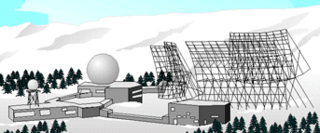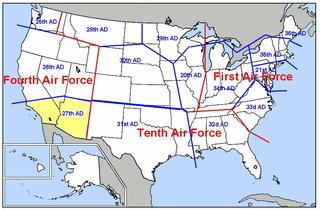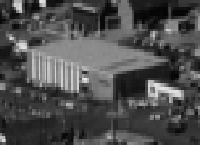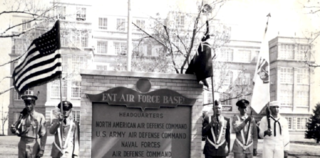
The Semi-Automatic Ground Environment (SAGE) was a system of large computers and associated networking equipment that coordinated data from many radar sites and processed it to produce a single unified image of the airspace over a wide area. SAGE directed and controlled the NORAD response to a possible Soviet air attack, operating in this role from the late 1950s into the 1980s. Its enormous computers and huge displays remain a part of cold war lore, and after decommissioning were common props in movies such as Dr. Strangelove and Colossus, and on science fiction TV series such as The Time Tunnel.

North American Aerospace Defense Command, known until March 1981 as the North American Air Defense Command, is a combined organization of the United States and Canada that provides aerospace warning, air sovereignty, and protection for Canada and the continental United States.

The Cheyenne Mountain Complex is a United States Space Force installation and defensive bunker located in unincorporated El Paso County, Colorado, next to the city of Colorado Springs, at the Cheyenne Mountain Space Force Station, which hosts the activities of several tenant units. Also located in Colorado Springs is Peterson Space Force Base, where the North American Aerospace Defense Command (NORAD) and United States Northern Command (USNORTHCOM) headquarters are located.
Ent Air Force Base was a United States Air Force base located in the Knob Hill neighborhood of Colorado Springs, Colorado. A tent city, established in 1943 during construction of the base, was initially commanded by Major General Uzal Girard Ent (1900–1948), for whom the base is named. The base was opened in 1951.

The RCA 474L Ballistic Missile Early Warning System was a United States Air Force Cold War early warning radar, computer, and communications system, for ballistic missile detection. The network of twelve radars, which was constructed beginning in 1958 and became operational in 1961, was built to detect a mass ballistic missile attack launched on northern approaches [for] 15 to 25 minutes' warning time also provided Project Space Track satellite data.

Peterson Space Force Base, previously Peterson Air Force Base, Peterson Field, and Army Air Base, Colorado Springs, is a United States Space Force base that shares an airfield with the adjacent Colorado Springs Municipal Airport and is home to the North American Aerospace Defense Command (NORAD), the Space Force's 21st Space Wing, elements of the Space Force's Space Systems Command, and United States Northern Command (USNORTHCOM) headquarters. Developed as a World War II air support base for Camp Carson, the facility conducted Army Air Forces training and supported Cold War air defense centers at the nearby Ent Air Force Base, Chidlaw Building, and Cheyenne Mountain Complex. The base was the location of the Air Force Space Command headquarters from 1987 to 20 December 2019 and has had NORAD/NORTHCOM command center operations since the 2006 Cheyenne Mountain Realignment placed the nearby Cheyenne Mountain Complex on standby. On 26 July 2021, the installation was renamed Peterson Space Force Base to reflect its prominent role in the new space service.

The National Military Command Center (NMCC) is a Pentagon command and communications center for the National Command Authority. Maintained by the Department of the Air Force as the "DoD Executive Agent" for NMCC logistical, budgetary, facility, and systems support; the NMCC operators are in the Joint Staff's J-3 (Operations) Directorate. "The NMCC is responsible for generating Emergency Action Messages (EAMs) to missile launch control centers, nuclear submarines, recon aircraft, and battlefield commanders".

Aerospace Defense Command was a major command of the United States Air Force, responsible for air defense of the continental United States. It was activated in 1968 and disbanded in 1980. Its predecessor, Air Defense Command, was established in 1946, briefly inactivated in 1950, reactivated in 1951, and then redesignated Aerospace rather than Air in 1968. Its mission was to provide air defense of the Continental United States (CONUS). It directly controlled all active measures, and was tasked to coordinate all passive means of air defense.

The 27th Air Division was a United States Air Force numbered air division and the geographic Air Defense Command region controlled by the 27th AD. Its last assignment was with Air Defense Command (ADC)'s Tenth Air Force, at Luke Air Force Base, Arizona. It was inactivated on 19 November 1969.

The 1st Space Operations Squadron is a United States Space Force unit responsible for space-based space domain awareness. Located at Schriever Space Force Base, Colorado, the squadron operates the Space Based Space Surveillance system, the Advanced Technology Risk Reduction system, the Operationally Responsive Space-5 satellite, and the Geosynchronous Space Situational Awareness Program.

The Chidlaw Building is a former United States Air Force facility located in the Knob Hill neighborhood of Colorado Springs, Colorado. The building was close to, but not within, the Ent Air Force Base complex, and was leased by the military for several decades, housing headquarters for several military commands, starting with the Air Defense Command (ADC) and the North American Aerospace Defense Command (NORAD). When Chidlaw was completed, personnel from multiple locations, including the Ent Air Force Base, were consolidated into the new building.

Cheyenne Mountain Space Force Station (CMSFS) is located in Cheyenne Mountain on the Front Range of the Rocky Mountains in unincorporated El Paso County, Colorado, next to Colorado Springs, The Cheyenne Mountain Complex, an underground facility within Cheyenne Mountain SFS, was first built for the North American Aerospace Defense Command (NORAD) Combat Operations Center, though NORAD moved day-to-day operations to its headquarters on Peterson AFB in 2006. However, day-to-day operations were moved back in 2011 after a major overhaul and renovation.

The Space Defense Center (SDC) was a space operation center of the North American Aerospace Defense Command. It was successively housed at two Colorado locations, Ent Air Force Base, followed by Cheyenne Mountain's Group III Space Defense Center The 1st Aerospace Control Squadron manned the SDC at both locations, which used the Electronic Systems Division's 496L System for processing and displaying data combined from the U.S. "Air Force's Space Track and the Navy's Spasur" (NAVSPASUR).
Space Detection and Tracking System, or SPADATS, was built in 1960 to integrate defense systems built by different branches of the United States Armed Forces and was placed under North American Aerospace Defense Command (NORAD). The Air Force had a program called Spacetrack, which was a network of space-probing cameras and radar. The Navy had a system called SPASUR, a space surveillance system that was "an electronic fence" the protected the southern United States.

The Denver Air Defense Sector was a United States Air Force geographic area designated during the Cold War for both air defense and air traffic control, as well as the name of the planned military unit for conducting radar surveillance and fighter-interceptor operations in the sector area. The Denver ADS spanned the entire state of Colorado, nearly all of Utah, most of Wyoming and western Nebraska, and small parts of Kansas, Oklahoma, New Mexico, Arizona, and Nevada. Potential targets in the sector included the military/industrial facilities and urban civilian populations of the metropolitan areas at Salt Lake City, Cheyenne, Denver, and Colorado Springs..
NORAD Control Centers (NCCs) were Cold War "joint direction centers" for command, control, and coordination of ground-controlled interception by both USAF Air Defense Command (ADC) and Army Air Defense Command (ARADCOM). The Joint Manual Steering Group was "formed by the Army and Air Force in July 1957 to support…collocation" of USAF Air Defense Direction Centers and Army Air Defense Command Posts, which began after a January 28, 1958, ADC/ARADCOM meeting with NORAD to "collocate the Fairchild-Geiger facilities" Army contracts for 5 NCCs had been let by August 17, 1958, after 1956 DoD approval for collocation of interim "pre-SAGE semiautomatic intercept systems" and radar squadrons at 10 planned Army Missile Master AADCPs

The Federal Building, originally the Burroughs Building, was a Cold War military computer systems building on the Ent Air Force Base in Colorado Springs. It was built in 1962 to be used by Burroughs Corporation for its project to build an automated facility to take input, like satellite and radar information, and instantaneously assess its degree of combat importance. The program was designed in conjunction with Air Force 425L System Project engineers and was an important component in North American Aerospace Defense Command (NORAD)'s command and control system. It was an Ent Air Force Base building until 1975 when the base was inactivated. It then became an off-base installation to the Peterson Air Force Base. Over the next several decades there were varying uses for the building by the federal government. After 2007, the building was vacated and in 2009 it was sold.

Continental Air Defense Command (CONAD) was a Unified Combatant Command of the United States Department of Defense, tasked with air defense for the Continental United States. It comprised Army, Air Force, and Navy components. It included Army Project Nike missiles anti-aircraft defenses and USAF interceptors. The primary purpose of continental air defense during the CONAD period was to provide sufficient attack warning of a Soviet bomber air raid to ensure Strategic Air Command could launch a counterattack without being destroyed. CONAD controlled nuclear air defense weapons such as the 10 kiloton W-40 nuclear warhead on the CIM-10B BOMARC. The command was disestablished in 1975, and Aerospace Defense Command became the major U.S. component of North American Air Defense Command (NORAD).

The Missile Warning Center (MWC) is a center that provides missile warning and defense for United States Space Command's Combined Force Space Component Command, incorporating both space-based and terrestrial sensors. The MWC is located at Cheyenne Mountain Space Force Station.
The GE 477L Nuclear Detection and Reporting System was a Cold War "Nuclear Detonation and Radioactive Fall-out Reporting System" for the National Military Command System. Planning/development began "by September 1, 1959, when NORAD had taken over responsibility from CONAD." In February 1961, General Electric and the sensor subcontractor Dresser agreed on a "team proposal" to the USAF. GE's oral proposal to the USAF was on October 18 1961, and in early November the GE/Dresser team was selected from 13 proposals. The contract was completed February 5 1962; specifications were approved June 1962; and the "target cost" and "target fee" amounts were $1,709,755 and $95,000. Lt Col Elmer Jones was the program chief at the System Program Office.

















